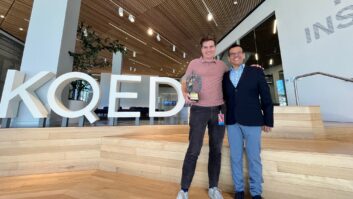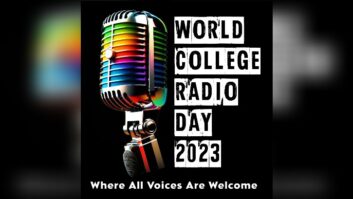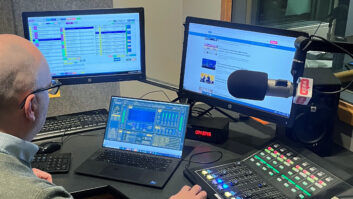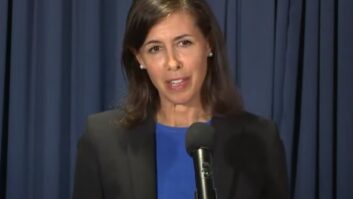In the earliest days of radio, every sound the listener heard was produced “live” including music, commercials, sound effects and the applause and laughter of a studio audience. In November, Entercom Seattle station KISW(FM) returned to those times but with a modern spin.

“We had rockaholics packed into the showroom of the Emerald Queen Casino in Tacoma,” said Ryan Castle, assistant program director of KISW and operations coordinator for Entercom. “Jason Dildine, our director of production was our director for the day, and Taz, our creative director, managed all the voice-over talent and the Foley artists.”
Wait, Foley artists? Those folks who normally walk in boxes of sand to simulate footsteps and slam doors and drop crates of broken glass to provide sound effects? Yes, those Foley artists were on hand for the entire day to add effects to live commercials and talk segments.
[Related: “Live Day Behind the Scenes“]
“They were great,” said Castle. “Seattle has a big community of these people who provide effects for movies and video games, and they brought in a table of bells, whistles and buckets of wet towels. They ad libbed everything! We gave them free rein to inject whatever they thought was appropriate, but they did know in advance what commercials we were going to read, so they weren’t going in completely cold.”
And in keeping with the “live day” theme, all music was played by musicians live in the studio.

“We had musical show introductions that featured cover versions of songs by Collective Soul, Alice in Chains and Soundgarden,” said Entercom Seattle Marketing Director Brian Thorpe. “These groups are what we normally play during the week, but for this event we used all local bands.”
KISW was so committed to the concept that it flew in its station voice-imaging talent Malcolm Ryker, who is based in San Diego, to handle station sweepers.
“We spent months planning this thing,” said Castle. “We figured if everything went as planned, that would be great, but if we crashed and burned it would still be great. That’s the joy of this.”

The station worked from a printed rundown that listed each event, minute by minute.
“We called it our bible,” said Castle. “I would work with the musicians to fill in the holes, and we tried to stick to it. It was supposed to resemble a normal broadcast day for us, but with a live audience.”
And did it all go as planned?
“I wouldn’t say it went without a hitch,” said Castle. “We had some hiccups, but if you were listening, you probably wouldn’t notice. For example, we would have to change bands quickly. One group might be playing an intro for a feature, and then we’d have to stall to get the next group set up.
“Everything was all done without a net, so it was unpredictable. If something was going wrong, we couldn’t cut to a record. We had no major trainwrecks, but even if we did, it would have been fine. If you go to NASCAR, the crashes are really cool!”
ATTENDANCE
Audience members paid $99.99 at the premium level to attend, which entitled them to a front-row reserved seat, breakfast and lunch. Because the broadcast ran from 6 a.m. to 6 p.m., people could come and go as they pleased. That same entrance fee also got each listener a T-shirt.
A halftime show featured a question and answer session with the on-air casts of the morning and afternoon shows, “BJ & Migs” and “The Men’s Room,” respectively.
Lower-priced tickets were available at $35, but a portion of all tickets sold went to hurricane relief efforts. The station raised $880 for this cause.

A video company was brought in to record the entire event so that “Live Day” could be streamed on www.kisw.com/media/live-day, where the content is still available, as well as on Facebook.
Read more about the technical aspects of the day in an article written by KISW Director of Production Jason Dildine.
Ken Deutsch describes himself as “a former air personality in the loosest sense of the term.” He says his tenure in radio began sometime after the potted palm era and ended when eight-track players in cars were something you would want to own.












